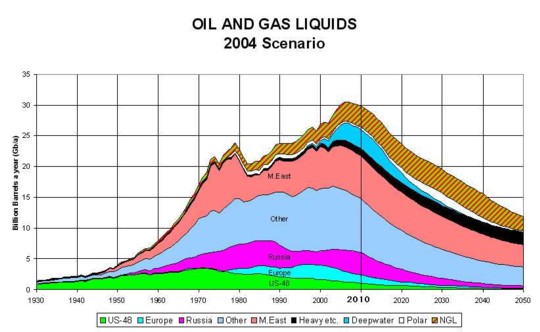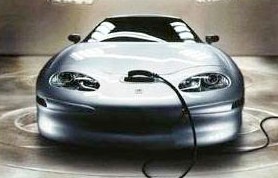|
 The
End of the Age of Oil 2005 - 2025 The
End of the Age of Oil 2005 - 2025
Increasing
Demand, Falling Supply
In
January 2005, ExxonMobil presented this graph to institutional
investors in New York.
It
shows oil production from existing fields now declining
by 4-6% p.a. while demand increases by 1.7% p.a.
By
2020, required new oil production alone
will have to equal total current global production to
keep up with demand.
One
third of World Oil Production now comes from declining
fields.
Oil
production has plateaued or is in decline in 33 of the
48 major oil producing nations including 6 of the 11
OPEC members.
By
2030, production from today's oil fields will have fallen
from 85Mb/d to 30Mb/d.
"The
World needs 10 new Saudi Arabias"
- Sadad Al Husseini, Head of Exploration, Saudi Aramco.
Analysis
by ODAC
of planned new oil field developments shows that after
2007, a seemingly unbridgeable gap opens up between
oil demand and supply. There is a rapid drop off in
new mega-project developments after 2006: by 2008 demand
will become constrained by a supply which has fallen
into decline.
The
latest analysis from the ASPO
indicates that oil production may already have reached
the Hubbert Peak or be about to do so. The graph below
was presented at the first ASPO workshop in Uppsala
in 2002.

Oil
Consumption Reduction Programme
90%
of our transportation is dependent on oil. 66% of US
oil consumption is used for transportation alone.
Reducing
the overwhelming reliance and dependence of our Road
Transportation systems on fossil fuel must be the immediate
priority.
A
Global Oil Consumption Reduction Programme must be implemented
forthwith to conserve oil supplies and implement alternative
sources of propulsion.
This
requirement to reduce oil dependence presents an enormous
Market Opportunity for the alternative energy and alternative
propulsion technology sectors. Those companies that
position themselves now to take advantage of the forthcoming
transition away from fossil fuel will achieve spectacular
growth.
The
Solution - The Plug In Hybrid and Battery Electric Vehicles
There
is one main technology available today that can reduce
oil consumption sufficiently in the timescale required
- the Plug-In Hybrid and the pure Battery Electric Vehicle.
The
Plug In Hybrid Electric Vehicle can offer 2 - 8 times
the fuel economy of the Internal Combustion Engine
Vehicle.
The
Battery Electric Vehicle (BEV) is some 10 times more
energy efficient than the internal combustion engine.
It is by far the most efficient form of road vehicle
possible.
The
Solution to the Peak Oil situation is simple. To mandate
that all new Light Vehicles sold must have a minimum
fuel economy of 100 miles per US gallon.
This
efficiency is now being demonstrated by a growing US
fleet of Toyota Priuses, retrofitted with larger plug
in batteries.
The
Daihatsu UFE II and III Hybrid prototypes have demonstrated
over 160mpg.
The
pure Battery EV demonstrates the greatest oil saving
of all. Apart from that, the cost of running a BEV in
Europe or the USA would be less than 10% of the cost
of an Internal Combustion Engine Vehicle (ICEV). Less
than 150 euros or dollars per year.
With
the latest battery technology, the BEV need no longer
be subject to limited range but can be designed with
a range comparable to petrol and diesel vehicles.
With
current technology, the Plug In Hybrid EV and the pure
Battery EV can complement each other for different markets:
the hybrid for assured longer range, the BEV for local
and urban use.
If
we implement a program to convert as much road transportation
to hybrid or pure electric power as possible, along
with expansion in biofuels where possible and adoption
of enhanced fuel efficiency technologies for the internal
combustion engine, we will have a viable pathway to
overcoming our dangerous dependence on fossil fuel and
to reducing oil consumption to manageable levels.
Conversion
of Road Haulage and Public Transport to Electric Propulsion
would have proportionately greater petroleum saving
benefits and should be prioritised.
Public
Transport and Utility fleets could be converted to Electric
Propulsion immediately with no inconvenience or change
required in operating patterns.
Central
Electricity Generation
The
total electricity required to power the whole UK road
vehicle fleet by electric propulsion would be at most
15% of the electricity currently generated in the UK.
Compared
with the 29 billion litres of fuel sold in the UK in
2001, it is clear how much more efficient and less polluting
Electric Propulsion would be.
Studies
indicate that at least 20% of the German car fleet could
be converted to electric power for no penalty; they
could be recharged overnight from off peak capacity
that is currently unused. In the Netherlands, the percentage
of the car fleet that could be powered by unused off-peak
capacity was put at 20-60%. We have a ready made buffer
already existing that can be used to reduce petroleum
consumption.
Load
levelling to reduce the differences between peak and
off-peak demand is of major importance for efficient
electricity generation. An EV fleet that recharges overnight
from off peak electricity would be of major benefit
to central electricity generating stations.
The
official electricity transmission losses alone in the
UK would power about 10% of the whole UK road vehicle
fleet. Technology exists to reduce these losses still
further.
In
the USA, the American Council for an Energy Efficient
Economy estimate that 24% of current US electricity
consumption could be easily saved. If this saving was
applied exclusively to power the US Light Vehicle Fleet,
US car drivers could drive 33% further than they do
today, replace all their petrol with electricity and
need generate no more electricity than they do today.
9.1Mb/d of oil would be saved.
Therefore
any requirement to build new electricity generating
capacity to power an EV fleet can be minimised: renewable
energy and CHP would be the most efficient ways to supply
this.
EV
Example - The GM EV1
 The
GM EV1 is the only dedicated Electric Car design to
have entered series production in recent times. With
modern NaNiCl batteries, its range between recharging
could be more than doubled to 300 miles. The
GM EV1 is the only dedicated Electric Car design to
have entered series production in recent times. With
modern NaNiCl batteries, its range between recharging
could be more than doubled to 300 miles.
Like
all the EVs introduced in minimal numbers in the late
1990s to meet the CARB rules, the 2 seater EV1 was handicapped
by lack of marketing and a prohibitive price - $500
per month for the improved 1999 version.
In
2005, General Motors crushed most of the EV1s that were
manufactured and removed it from the Smithsonian Museum.
The EV1 was the most aerodynamically efficient car ever
produced.
2007:
Peak Oil - The
EV Imperative
For
more information see 2007:
Peak Oil - The EV Imperative
|
